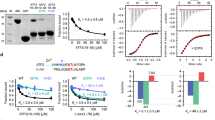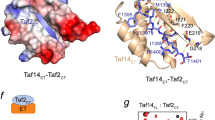Abstract
The ATFa proteins, which are members of the CREB/ATF family of transcription factors, display quite versatile properties. We have previously shown that they interact with the adenovirus E1a oncoprotein, mediating part of its transcriptional activity and heterodimerize with the Jun, Fos or related transcription factors, thereby modulating their DNA-binding specificity. In the present study, we report the sequence requirement of the N-terminal activation domain of ATFa and demonstrate the importance of specific threonine residues (Thr51 and Thr53) in addition to that of the metal-binding domain, in transcriptional activation processes. We also show that the N-terminal domain of ATFa which stably binds the Jun N-terminal kinase-2 (JNK2) (Bocco et al., 1996), is not a substrate for this kinase in vivo but, instead, serves as a JNK2-docking site for ATFa-associated partners like JunD, allowing them to be phosphorylated by the bound kinase.
This is a preview of subscription content, access via your institution
Access options
Subscribe to this journal
Receive 50 print issues and online access
$259.00 per year
only $5.18 per issue
Buy this article
- Purchase on Springer Link
- Instant access to full article PDF
Prices may be subject to local taxes which are calculated during checkout





Similar content being viewed by others
References
Allegretto EA, Smeal T, Angel P, Spiegelman BM and Karin M. . 1990 J. Cell. Biochem. 42: 193–206.
Angel P and Karin M. . 1991 Biochim. Biophys. Acta 1072: 129–157.
Benbrook DM and Jones NC. . 1990 Oncogene 5: 295–302.
Bocco JL, Bahr A, Goetz J, Hauss C, Kallunki T, Kedinger C and Chatton B. . 1996 Oncogene 12: 1971–1980.
Boyle WJ, Van Der Geer P and Hunter T. . 1991 Meth. Enzymol. 201: 110–149.
Brusselbach S, Mohle-Steinlein U, Wang ZQ, Schreiber M, Lucibello FC, Muller R and Wagner EF. . 1995 Oncogene 10: 79–86.
Cavigelli M, Dolfi F, Claret FX and Karin M. . 1995 EMBO J. 14: 5957–5964.
Chatton B, Bocco JL, Gaire M, Hauss C, Reimund B, Goetz J and Kedinger C. . 1993 Mol. Cell. Biol. 13: 561–570.
Chatton B, Bocco JL, Goetz J, Gaire M, Lutz Y and Kedinger C. . 1994 Oncogene 9: 375–385.
Chatton B, Bahr A, Acker J and Kedinger C. . 1995 Biotechniques 18: 142–145.
Chen C and Okayama H. . 1987 Mol. Cell. Biol. 7: 2745–2752.
Derijard B, Hibi M, Wu IH, Barrett T, Su B, Deng T, Karin M and Davis RJ. . 1994 Cell 76: 1025–1037.
Flint KJ and Jones NC. . 1991 Oncogene 6: 2019–2026.
Fuchs SY, Dolan L, Davis RJ and Ronai Z. . 1996 Oncogene 13: 1531–1535.
Fuchs SY, Xie B, Adler V, Fried VA, Davis RJ and Ronai Z. . 1997 J. Biol. Chem. 272: 32163–32168.
Gaire M, Chatton B and Kedinger C. . 1990 Nucl. Acids Res. 18: 3467–3473.
Goetz J, Chatton B, Mattei MG and Kedinger C. . 1996 J. Biol. Chem. 271: 29589–29598.
Gorman CM, Moffat LF and Howard BH. . 1982 Mol. Cell. Biol. 2: 1044–1051.
Green S, Issemann I and Sheer E. . 1988 Nucl. Acids Res. 16: 369.
Gupta S, Campbell D, Derijard B and Davis RJ. . 1995 Science 267: 389–393.
Hai T and Curran T. . 1991 Proc. Natl. Acad. Sci. USA 88: 3720–3724.
Hibi M, Lin A, Smeal T, Minden A and Karin M. . 1993 Genes Dev. 7: 2135–2148.
Ivashkiv LB, Liou HC, Kara CJ, Lamph WW, Verma IM and Glimcher LH. . 1990 Mol. Cell. Biol. 10: 1609–1621.
Kallunki T, Su B, Tsigelny I, Sluss HK, Derijard B, Moore G, Davis R and Karin M. . 1994 Genes Dev. 8: 2996–3007.
Kallunki T, Deng TL, Hibi M and Karin M. . 1996 Cell 8: 929–939.
Karin M. . 1995 J. Biol. Chem. 270: 16483–16486.
Kovalenko OV, Plug AW, Haaf T, Gonda DK, Ashley T, Ward DC, Radding CM and Golub EI. . 1996 Proc. Natl. Acad. Sci. USA 93: 2958–2963.
Kumar V and Chambon P. . 1988 Cell 55: 145–156.
Kunkel TA, Roberts JD and Zakour RA. . 1987 Meth. Enzymol. 154: 367–382.
Kyriakis JM and Avruch J. . 1996 Bioessays 18: 567–577.
Lee KA. . 1992 J. Cell Sci. 103: 9–14.
Leff T, Elkaim R, Goding CR, Jalinot P, Sassone-Corsi P, Perricaudet M, Kedinger C and Chambon P. . 1994 Proc. Natl. Acad. Sci. USA 81: 4381–4385.
Leid M, Kastner P, Lyons R, Nakshatri H, Saunders M, Zacharewski T, Chen JU, Staub A, Garnier JM, Mader S and Chambon P. . 1992 Cell 68: 377–395.
Liu F and Green MR. . 1990 Cell 61: 1217–1224.
Liu F and Green MR. . 1993 Nature 366: 531–536.
Livingstone C, Patel G and Jones N. . 1995 EMBO J. 14: 1785–1797.
Maekawa T, Matsuda S, Fujisawa J, Yoshida M and Ishii S. . 1991 Oncogene 6: 627–632.
Marshall CJ. . 1995 Cell 80: 179–185.
Minden A and Karin M. . 1997 Biochim. Biophys. Acta 1333: F85–F104.
Musti AM, Treier M and Bohmann D. . 1997 Science 275: 400–402.
Papavassiliou AG, Treier M and Bohmann D. . 1995 EMBO J. 14: 2014–2019.
Rochette-Egly C, Lutz Y, Pfister V, Heyberger S, Scheuer I, Chambon P and Gaub MP. . 1994 Biochem. Biophys. Res. Commun. 204: 525–536.
van Dam H, Duyndam M, Rottier R, Bosch A, de Vries-Smits L, Herrlich P, Zantema A, Angel P and van der Eb AJ. . 1993 EMBO J. 12: 479–487.
van Dam H, Wilhelm D, Herr I, Steffen A, Herrlich P and Angel P. . 1995 EMBO J. 14: 1798–1811.
van Dam H, Huguier S, Kooistra K, Baguet J, Vial E, van der Eb AJ, Herrlich P, Angel P and Castellazzi M. . 1998 Genes Dev. 12: 1227–1239.
Wang H, Xie Z and Scott RE. . 1996 Oncogene 13: 2639–2647.
Webster NJ, Green S, Jin JR and Chambon P. . 1988 Cell 54: 199–207.
Whitmarsh AJ and Davis RJ. . 1996 J. Molec. Med.-Imm. 74: 589–607.
Acknowledgements
We thank S Adam, P Angel, M Karin, C Rochette-Egly and B Wasylyk for gift of materials and H Boeuf, M Rosa-Calatrava and M Vigneron for very helpful discussions. We are grateful to the staff of the cell culture, nucleotide sequencing and oligonucleotide synthesis, and artwork facilities for providing help and material. This work was supported by funds and/or fellowships from the Centre National de la Recherche Scientifique, the Institut National de la Santé et de la Recherche Médicale, the Centre Hospitalier Universitaire Régional, the Association pour la Recherche sur le Cancer, the Ligue Nationale contre le Cancer, the Université Louis Pasteur de Strasbourg.



